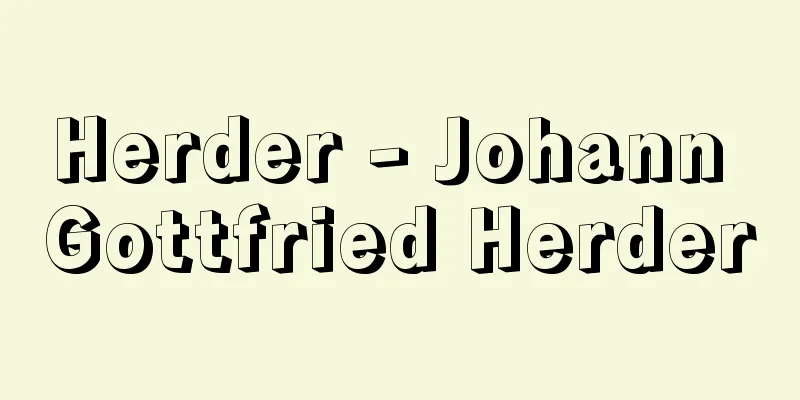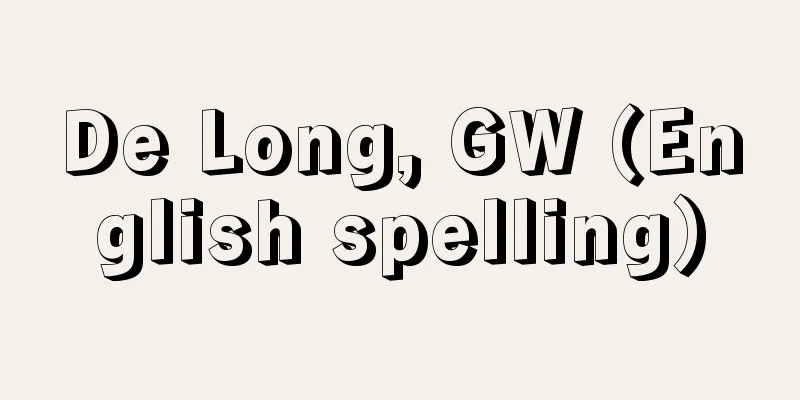Herder - Johann Gottfried Herder

|
German thinker. Born on August 25th in Molungen, East Prussia, as the son of an elementary school teacher. He studied theology and philosophy at the University of Königsberg, where he was influenced by Kant and also studied under the mystic J. G. Herman. In 1764, he became a teacher at the Cathedral School in Riga (the capital of the Republic of Latvia), and published "Fragments on Modern German Literature" (1767) and "Critical Essays" (1769), becoming famous at a young age. In 1769, he left Riga and traveled to France and southern Germany, and in his "Travel Journal" (1769), he wrote of his awareness of his own country's culture, which was different from that of France, saying, "My path passes through the dim arches of Gothic buildings and follows the shadows beneath the green rows of trees." He met the young Goethe in Strasbourg and initiated the Sturm und Drang movement. In 1771 he became the court chaplain of Bückeburg, and in 1776, on Goethe's recommendation, he was appointed superintendent of Weimar, where he spent the rest of his life. He died on December 18, 1803. His intellectual activities were extremely diverse, but in the field of literary theory, he wrote works such as On Ossian (1773), On Shakespeare (1773), Folk Songs (1778-1779), and The Spirit of Hebrew Literature (1782-1783). All of these works were groundbreaking works that brought about a revolution in the Enlightenment's intellectualistic view of literature, rejecting the so-called three unities that formed the basis of the conventional view of literature, and the view that the works of classical antiquity were the norm for literature in general, and instead proclaiming that the freedom of the creative spirit was the fundamental principle of literature, while at the same time establishing the position that the history and climate of a nation are the foundation for the establishment of literature and art. In the field of linguistic thought, he wrote works such as Discourse on the Origin of Language (1772), in which he argued that language is not merely an arbitrary code for things and ideas, questioned the relationship between language, consciousness, and things from an anthropological perspective, and understood language, particularly from the perspective of one's mother tongue, in relation to the formation of a nation's culture, which laid the foundation for Humboldt's philosophy of language.Furthermore, in the field of historical philosophy, his major works include Heterogenous Philosophy of History for the Formation of Human Nature (1774) and Ideas (Ideas for the Philosophy of Human History) (1784-1791).While the common understanding of history is that it is a concept opposed to nature, Humboldt overturned this and established a unique view of history that grasps the human spirit and the natural world from a unified standpoint. In particular, in "Heretics," he introduced the idea of the individuality of historical events in relation to nations and eras, paving the way for later historicism, while in "Ideas," he is distinctive in that he grasps the various aspects of the development of human culture within the framework of an eschatological view based on the idea of the development of humanity. This is based on a unique understanding of the Christian concept of revelation. Herder, who was a priest in charge of the Weimar diocese, also served as assessor and later as director of the Religious Affairs Bureau of the Duchy of Weimar, but he devoted himself most to reforming the education system in the Duchy. His idea of educating humanity was fortunately supported by the Duchy's Chancellor Goethe, and he achieved many successes. His epitaph on his grave in the Central Church of Weimar reads, "Licht, Liebe, Leben" (Light, Love, Life). [Yoshiki Shichiji August 21, 2018] "On the Origin of Language, translated by Kimura Naoji (1972, Taishukan Shoten)" ▽ "Shakespeare, translated by Tobari Masami (included in "The World's Masterpieces 38: Herder and Others", 1979, Chuokoron-Shinsha)" ▽ "A Different Theory of the Philosophy of History for the Formation of Humanity, translated by Oguri Hiroshi and Shichiji Yoshinori (included in "The World's Masterpieces 38: Herder and Others", 1979, Chuokoron-Shinsha)" [References] | | |Source: Shogakukan Encyclopedia Nipponica About Encyclopedia Nipponica Information | Legend |
|
ドイツの思想家。8月25日、東プロイセンのモールンゲンに小学校教師の子として生まれる。ケーニヒスベルク大学で神学と哲学とを学び、カントの影響を受けるとともに神秘的思想家J・G・ハーマンに私淑した。1764年リガ(ラトビア共和国の首都)の司教座聖堂付属学校教師となり、『近代ドイツ文学断想』(1767)、『批評論叢(ろんそう)』(1769)を発表し若くして名を知られた。1769年、リガを去りフランス・南ドイツへ旅したが、『旅日記』(1769)に「わがゆく道はゴシックの仄(ほの)暗いアーチをくぐり緑の並木の下翳(したかげ)を辿(たど)る」と、フランスとは異なる自国文化への魂の自覚を記している。ストラスブール(シュトラスブルク)で若いゲーテと出会い、「シュトゥルム・ウント・ドラング」(疾風怒濤(しっぷうどとう))運動のきっかけをつくった。1771年ビュッケブルクの宮廷牧師となり、1776年ゲーテの推薦でワイマールの教区総監督に迎えられ、その地で終生過ごした。1803年12月18日没。 彼の思索活動はきわめて多岐にわたるが、まず文芸理論の分野では『オシアン論』(1773)、『シェークスピア論』(1773)、『民謡集』(1778~1779)、『ヘブライ文学の精神』(1782~1783)などがあげられる。いずれも啓蒙(けいもう)思想の主知主義的文芸観に変革をもたらした画期的著作で、在来の文学観の基礎にあった、いわゆる三統一の法則および古典古代の作品を文芸一般の規範とみなす見方を退け、創造精神の自由こそ文学の原理であるとし、同時に民族の歴史と風土を文学芸術成立の基盤とみる立場を確立した。また言語思想の面では『言語起源論』(1772)ほかがあり、言語とは事物や観念の単なる恣意(しい)的な符丁(ふちょう)ではないとし、言語と意識と事物の関係を人間論的に問うとともに、言語をとりわけ母国語の面から民族の文化形成との関連によりとらえたことは、フンボルトの言語哲学への礎石を据えるものとなった。さらに歴史哲学の領域では、主要著作として、『人間性形成のための歴史哲学異説』(1774)、『イデーン(人間史の哲学の諸理念)』(1784~1791)がある。歴史を自然に対立する概念とみなすのが通常一般のとらえ方であるとすれば、これを転換して、人間精神と自然世界とを統一的立場により把握する独自な歴史観を確立した。とくに『異説』では、民族や時代について歴史事象の個体性の観念を導き入れ、後の歴史主義へと道を開く一方、『諸理念』では、人間文化の展開の諸相を、人間性の発展の理念のもとに終末観の枠組みによりとらえたところに特徴がある。これは、キリスト教的啓示概念の独自な把握に基づくものである。 聖職者としてワイマール教区を預かる地位にあったヘルダーは、またワイマール公国の宗教局評定官、のち長官の職についたが、もっとも腐心したのは公国内の教育制度の改革であった。彼の人間性の教育の理念はさいわい公国宰相ゲーテの支持を受け、幾多の実績をあげることとなる。ワイマール中央教会内に埋葬されている彼の墓碑銘には「光、愛、生命」Licht,Liebe,Lebenと記されている。 [七字慶紀 2018年8月21日] 『木村直司訳『言語起源論』(1972・大修館書店)』▽『登張正実訳『シェイクスピア』(『世界の名著38 ヘルダー他集』所収・1979・中央公論社)』▽『小栗浩・七字慶紀訳『人間性形成のための歴史哲学異説』(『世界の名著38 ヘルダー他集』所収・1979・中央公論社)』 [参照項目] | | |出典 小学館 日本大百科全書(ニッポニカ)日本大百科全書(ニッポニカ)について 情報 | 凡例 |
Recommend
Blue-green alder - Blue-green alder
...The leaves of this plant are somewhat similar ...
Actor - Haiyuu
A person who performs in front of an audience usi...
Baluchitherium
A fossil rhinoceros that existed from the late Oli...
"Kizaki Ondo" - Kizaki Ondo
...The name of a folk song. A typical Bon Odori s...
Querinus School - Querinus School
…In this respect, he resembles the British painte...
Thundering Formation - Kaminari no Jin
Since the Nara period, this refers to the practice...
Luckmann, T.
…However, excessive attachment to subjectivist ap...
Izumo Taisha Shinko Festival
...Also written as "Saigo-sai" or "...
Luqmān (English spelling)
A legendary figure known in the Arab-Islamic world...
Balazsfalva (English spelling) Balazsfalva
…Population 23,000 (1983). Hungarian: Balázsfalva...
Ise iris - Ise iris
...In the Meiji era, the Mangetsukai was formed i...
Deukalion - Deukalion (English spelling)
The ancestor of mankind in Greek mythology. He wa...
Mr. Abe - Abeuji
One of the surnames of hereditary feudal lords an...
Interference
In wireless communication, interference occurs whe...
"Golden Bell" - Kinrei
…In 1916, he entered the school of Sasaki Nobutsu...





![Kanazu [town] - Kanazu](/upload/images/67cb3a741f807.webp)



